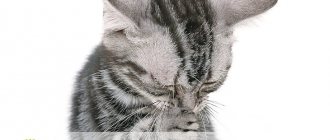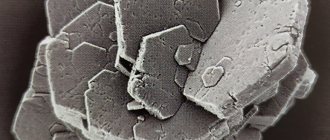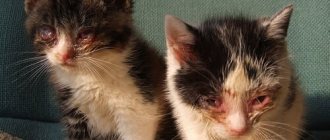Cystitis in cats is a common problem characterized by inflammation in the urinary system. The disease constantly returns and becomes chronic, so owners will need to carefully monitor the health of their pet. The disease is accompanied by a lot of difficulties, but timely diagnosis makes it possible to successfully treat cystitis.
The risk group includes cats with weak immune systems that prefer a minimum of movements. Young or old animals, pregnant women, those treated with corticosteroids - all of these categories have an increased risk of developing pathology.
Inflammation of the bladder causes suffering in pets. They have a weakened immune system, are prone to obesity, and infection can even be acquired during surgery.
The danger of cystitis in cats
Lack of diagnosis and treatment leads to a sharp exacerbation of the symptoms of cystitis, which provokes serious complications. Bacteria, entering the body, spread through the blood and penetrate the kidneys, which causes renal failure and peritonitis. The reproductive system is often affected.
There is a deviation in the alkaline environment of urine, and stones form. Cats are more susceptible to urolithiasis; they have a narrower and more tortuous urethra. A small amount of sediment is enough to block the passage. The salt plug stops the excretion of urine. The life expectancy of a pet in such an extreme situation, without medical assistance, will be several days.
Untreated cystitis becomes chronic. Relapse of the disease is provoked even by banal hypothermia. Treatment should be carried out only if the presence of cystitis is confirmed. The inflammatory reaction may be caused by another disease that will need to be eliminated first.
Diet for cystitis
If a sterile non-infectious process is detected, a long course of diet therapy will be prescribed. Minimum medicinal feeds are prescribed for a month.
For example, in the treatment of urolithiasis, food is used to acidify urine, preventing the formation of struvite-type stones and crystals. These foods include: Hill's S/D, Proplan Purina Urinary, Royal Canin Urinary S/O or their analogues.
When treating idiopathic stress cystitis, food is usually prescribed to increase the period of remission and reduce the likelihood of relapses. For example Hill's C/D.
This food contains the essential amino acid L-tryptophan, which reduces the risk of stress.
Only a doctor can select the correct type and duration of feeding after a complete examination of the patient.
Causes of the occurrence and development of the disease
Both external and internal factors can provoke inflammation, namely:
- infection of the urinary system;
- helminths;
- diabetes, in which the level of glucose and protein increases, creating conditions acceptable for bacteria;
- eating low-quality feed, overeating;
- low fluid intake when regularly eating dry food;
- walking in low temperatures;
- the formation of salt deposits and calculi in the urine;
- infection that has become chronic (leukemia);
- pelvic injuries as a result of an unsuccessful jump;
- damage to the reproductive system (endometritis), complications after childbirth.
Even stress can provoke inflammation. It negatively affects the immune system and weakens it. Cats are lovers of cleanliness, unsanitary conditions in the house, an uncleaned litter box - all this becomes the cause of cystitis.
Frequent abstinence increases the concentration of urine, creating an acceptable environment for the development of pathogenic microorganisms. A capricious pet needs to be carefully monitored, changing its tray daily.
Common causes of the disease
Cystitis occurs as an independent disease, but in some cases it can be a consequence of any disease. Most often diagnosed in small kittens. With age, the likelihood of developing cystitis gradually decreases. It is often observed in animals whose immune systems are severely weakened (for example, after an infection).
Common causes of cystitis in cats:
- Frequent stress.
Stressful situations lead to disruption of the production of cortisol (a steroid hormone) in the cat’s body, which causes inflammation of the bladder.
- Mechanical damage and trauma in the pelvic area.
Severe injuries or bruises (for example, from falls from a great height) can lead to damage to the musculoskeletal system, and then to cystitis.
- Hypothermia.
The likelihood of bladder inflammation increases if the cat lives in a cold or damp, drafty room.
- Poor nutrition.
If your pet's diet contains only dry food and there is no sufficient access to water, the composition of the urine changes. This can lead to the development of a severe inflammatory process.
- Disorders of the urinary system.
Chronic diseases (for example, urolithiasis or pyelonephritis) can lead to irritation of the mucous membranes and the occurrence of cystitis.
- Obesity or physical inactivity.
These problems are common in spayed and neutered male cats. They can lead to stagnation of blood in the urinary system, which will cause an inflammatory process.
Classification by type of inflammation
Pathology is divided into 7 types, according to the cause of occurrence and accompanying symptoms. Treatment follows a similar scheme, despite the differences.
Idiopathic
This variety is characterized by the absence of factors provoking inflammation. The manifested symptoms have varying degrees of severity.
From the point of view of veterinarians, one of the causes of the disease is stress. They disrupt the neuroendocrine regulation of the bladder. Hormones are actively released that increase vascular permeability. The result is the appearance of vulnerability of the walls of the bladder.
Purulent
A plaque of pus is present in pets with weak immunity. The nature of the disease is bacterial. An active inflammatory process provokes intoxication and fever. Urine has small clots of pus mixed with bloody streaks and pieces of tissue covering the bladder.
Ulcerative
This form is a complication of purulent pathology. The muscle tissue is subject to deformation, and festering ulcers appear on it.
Phlegmonous
This type of pathology does not have clear boundaries. The mucous membranes contain white blood cells produced by the body to suppress infection. Such cystitis often occurs with immunodeficiency and paracystitis, characterized by an inflammatory process in the tissue of the bladder.
Gangrenous
Extremely severe form. One likely outcome is the development of peritonitis. Inflammation is present throughout the organ, causing tissue necrosis.
Hemorrhagic
Refers to purulent and serous-catarrhal forms of cystitis. Blood vessels become thinner, their permeability increases, which is accompanied by severe hemorrhage, red blood cells are released along with the urine. The urine will contain red bloody clots.
Urolithiasis causes damage to internal tissues. The passage that removes urine becomes clogged with dense blood clots.
Serous-catarrhal
This form of cystitis is characterized by profuse swelling of the mucous membrane and dilation of blood vessels. Particles of the urinary epithelium begin to flake off. Excessive levels of leukocytes cause the formation of inflammatory exudate. Urine becomes cloudy, as dead cells, mucus, and other products formed under the influence of inflammation are excreted along with it.
The newest moments of "history"
Interstitial cystitis may be a consequence of neurogenic inflammation due to defects in the urinary tract mucosa. The description of the pathology is:
- predisposition of young animals;
- pain when emptying the bladder (urine is sterile);
- often hematuria;
- hemorrhages in the submucosal layer (“nodules” during cystoscopy).
It is assumed that neurogenic inflammation develops due to the exposure of nerve endings, which begin to be affected by compounds that should not normally do so. When signals are transmitted to the overlying centers, an axonal reflex develops, with the final release of histamine and provocation of the inflammatory process in the urethra, which can cause the development of symptoms typical of cystitis.
Neuro-endocrine changes - associated with a stress reaction to surrounding events, people, crowded housing, etc. With interstitial cystitis, the risk group for neuro-endocrine changes included: cats, high-breed, long-haired cats with excess body weight.
Some of the owners' complaints include walking around in addition to the litter box, and "small" movements everywhere in the house. When collecting anamnesis, it turned out that the animals were kept crowded or had conflicts with other cats. Access to the tray may have been “blocked”, or without the desired type of filler, so this could be cited as a risk factor for idiopathic cystitis.
Thus, idiopathic cystitis in cats today can be interpreted as a pathology that stands at the crossroads of physiological and behavioral causes.
Forms of flow
Based on the severity of symptoms, cystitis can be divided into acute and chronic forms. The first variety is the starting one. Lack of treatment for a long time allows the pathology to progress into a chronic form.
In the acute form, the entire list of symptoms is present. The animal suffers from pain and may empty its bladder outside the tray. A pronounced character appears soon after exposure to a pathogenic factor. If you take the animal to the veterinarian in time, it will be possible to restore the soft tissues of the affected organ, and the inflammation will not have time to cause significant harm to them.
Chronic pathology has episodic symptoms. The cat may get better, but the disease will periodically return. Chronic cystitis weakens the immune system and negatively affects life expectancy. The muscle tissue of the affected organ becomes thicker, which prevents the animal from recovering. Recurrence of cystitis can occur more than twice a year, occurring in an acute form.
"Stop-Cystitis for cats."
“Stop-Cystitis” tablets for cats are a natural drug for the prevention and treatment of urinary tract diseases and urolithiasis. Tablets are prescribed for the treatment and prevention of acute and chronic inflammatory and infectious diseases of the urinary tract, such as cystitis, and urolithiasis; prevention of infections during diagnostic procedures; in the postoperative period, after removal of urinary stones in cats and dogs. The drug has anti-inflammatory, antimicrobial, antiseptic, diuretic effects; reduces crystallization and prevents the formation of urinary stones. As mentioned earlier, this drug is made on the basis of natupal medicinal plants, such as knotweed grass, nettle leaves, horsetail, lingonberry leaves, licorice roots, birch leaves. It also contains vitamins and mineral compounds, flavonoids and tannins. And also in its composition, as in the composition of the drug “No-shpa”, it contains drotaverine, which relieves painful spasms in the animal.
Symptoms of pathology
It is not difficult to detect the presence of the disease, since the animal changes its lifestyle and uncharacteristic habits appear.
The key symptoms of cystitis are as follows:
- frequent use of the litter box, but the volume of urine released will be reduced;
- the cat begins to purr or meow plaintively due to the discomfort present;
- the urine has changed color and there is blood or pus in it;
- the stool has acquired a putrid or ammonia-like odor;
- depressed state, lack of physical activity, partial or complete refusal to eat;
- increase in body temperature;
- pain when lightly pressing the bladder.
Cats are associative animals. They will attribute pain during urination to the litter box, trying to avoid it in the future. The transition to a chronic form becomes a real problem. The cat does not control the excretion of urine; the weakened walls of the bladder no longer hold urine. The only way out of this situation is the use of specialized diapers.
Main symptoms of cystitis
Depending on the stage of development of the pathology, clinical signs can vary from barely noticeable to pronounced. You can notice the symptoms of cystitis by observing the cat’s behavior and his trips to the toilet. At the same time, it is important to know the characteristics of the symptoms of cystitis in order to be able to seek professional help in time.
The main manifestations come down to two types of urination disorders:
- The cat sits in the tray for a long time (from 2-5 to 30 or more minutes), struggling to urinate. As a result, it is possible to “squeeze out” only a small amount of urine, and the urge to urinate does not leave the sick pet.
- Urination occurs without difficulty; on the contrary, too much urine is excreted at one time. With this course of the disease, urinary incontinence is also often observed, and the owners observe drops or small puddles throughout the house, in places where the cat was or passed.
In addition to the common symptoms mentioned above, other signs of cystitis are often present:
- Painful sensations of varying severity, they can be constant or occur directly in the process (when trying) to urinate. As a result, the cat behaves restlessly, may try to go to a place other than the litter box to relieve itself, and meows or hisses loudly.
- Hematuria is another common manifestation in which blood is found in the urine. Typically, this symptom is present in the later stages of cystitis progression or when it is initially severe.
In most cats, due to urocystitis, their appetite also decreases and their overall body temperature may increase.
Important!
If you notice any of the described signs, you need to take your pet to the veterinarian as soon as possible, the doctor will help reduce the suffering and prescribe the necessary medications.
Diagnostics in a veterinary clinic
Preliminary diagnosis consists of collecting anamnesis, assessing the general condition of the pet, and palpation. A complete picture can be obtained after the following procedures:
- studying blood and urine tests, any deviations from the norm will be displayed in an unstandardized number of basic indicators;
- blood biochemistry studies, analysis will help determine the degree of damage to the urinary system;
- Ultrasound, which helps to track the presence or absence of tumors in the kidneys;
- Bacteriological culture can determine sensitivity to antibiotics, and the causative agent of the disease is determined.
If necessary, x-rays and cystoscopy are prescribed. Cystoscopy focuses on the inner surface of the bladder. The image will allow you to track the condition of the internal organs.
Diagnosis of the disease
To choose effective treatment, the veterinarian needs to make an accurate diagnosis and determine the cause of the disease. Cystitis is preliminarily diagnosed based on a thorough examination, palpation of the abdominal area and anamnesis obtained from the cat’s owner.
If necessary, the veterinarian prescribes the following diagnostic methods:
- Analysis of urine,
- ultrasound examination of the genitourinary system (allows to detect thickening of the bladder),
- bacterial culture of urine,
- X-ray examination of the urinary system.
If your cat has previously been diagnosed with cystitis, be sure to tell your veterinarian. The fact is that diseases of the lower urinary tract in animals are a lifelong problem. This means that an episode of illness, even with proper treatment, may recur in the future.
First aid and treatment
If the animal is suffering from severe pain, an antispasmodic may be used. The exact dosage depends on the weight and age of the pet, but it must be agreed with your veterinarian.
Temporary abstinence from food will help reduce the load on the kidneys, but you need to monitor your fluid intake. This helps reduce the concentration of urine and remove some bacteria from the body.
The pet should be placed in a place protected from drafts to prevent the progression of cystitis. It is not recommended to carry out palpation on your own; excess pressure on the organ can lead to rupture of soft tissues.
Instructions for use of the Stop-Cystitis suspension for cats
Before use, the bottle with the feed additive should be shaken thoroughly for 1 - 2 minutes.
Stop Cystitis Bio is used in cats and dogs to normalize and improve the functioning of the urinary system, as well as in combination with medications for urological syndrome, urolithiasis and in the postoperative period after removal of urinary stones.
The drug is given to animals individually with food or injected directly onto the root of the tongue using a dispenser syringe 2 times a day for 10 - 14 days.
The suspension is packaged in a 30 ml polymer bottle with a screw-on plastic cap. The bottles are packaged individually in a cardboard box along with instructions for use and a dispenser syringe.
Store the drug in the manufacturer's sealed packaging, in a place protected from direct sunlight, separately from food and feed at a temperature of 0 °C to 25 °C. Must be stored out of the reach of children.
Shelf life, subject to storage conditions, is 2 years from the date of production.
I agree with the reviews of cat owners, the drug “Stop-Cystitis for Cats” is an excellent preventive drug, it helps well with urolithiasis, is very effective in the treatment of cystitis and is very convenient to use.
Stop-Cystitis for cats is , you have read the instructions for use, all we have to do is find out the price of the drug and find out reviews from the owners of furry cats.
According to reviews the drug “Stop-Cystitis for cats ” is easy to use (see instructions ), has a mild effect, an affordable price , is economically used and has a very good preventive effect.
The drug “Stop cystitis tablets for dogs”, as well as the drug “Stop cystitis suspension for cats”, has the same effects as the drug for cats that were described above. The difference is only in the amount of active substances and packaging of the drug. For example, the tableted drug “Stop-Cystitis for Dogs” is sold in a blaster that contains 20 tablets. The price of “Stop-Cystitis for Dogs” is also completely affordable, and in the instructions that you will find inside the package, you will learn how to use the drug at home if your dog has symptoms of cystitis.
Procedures at the veterinary clinic
Veterinarians clean the bladder. The procedure is carried out using a catheter with an antibiotic and an antiseptic (boric acid, Furacilin, KotErwin). If there is a critical lack of fluid in the body, a dropper with Ringer's solution or glucose is placed.
In a critical situation, combined with a risk to life, surgical intervention may be performed. The veterinarian artificially empties the bladder if it is filled with urine and the natural passage is tightly blocked. In other cases, conservative treatment is carried out at home.
Causes of cystitis
Most often, cystitis is provoked by normal microflora - these are bacteria that “live” in the bladder constantly. In a healthy cat, they do not destroy the organ mucosa and do not cause clinical symptoms. When exposed to triggers, the immune system weakens and microbes can cause cystitis.
Such provoking factors include:
- hypothermia;
- frequent stress;
- poor nutrition;
- vitamin deficiencies;
- taking certain potent drugs;
- accompanying pathologies.
When exposed to them, the body's defenses are depleted and it is unable to resist infection. Sometimes other concomitant diseases arise that also require treatment. In some cases, cystitis develops spontaneously, without exposure to provoking factors.
How to care for an animal
During treatment, the animal must be isolated from drafts and not allowed to lie on the tiles. Heating the bedding is also not recommended. There are a number of other useful recommendations:
- no walks. On a warm and clear day, you can go out with your pet in your arms to saturate its body with oxygen;
- It is forbidden to bathe a cat until complete recovery;
- make sure there is enough fluid. For picky animals, you can install electric fountains, host mugs or buckets, and place them in different rooms;
- do not expose your pet to stress;
- Visit your veterinarian regularly to monitor changes in health.
Particular attention should be paid to weak, pregnant or lactating pets. Low immunity accelerates the development of inflammation, which affects the kidneys.
Recommended treatment regimens
There is no single correct treatment regimen for idiopathic cystitis, since the basis of any treatment is always the elimination of the root cause. But in the case of urological syndrome, this is almost impossible to do.
What they do:
- bladder lavage;
- prescription of antispasmodics;
- give anti-inflammatory drugs (NSAIDs and glucocorticoids, but there are risks: nephrotoxicity, azotemia, infectious complications);
- Amitriptyline is prescribed (relief of stress, depression, but there are risks of blockage and AUR).
Diet therapy is a method that is always accepted by veterinarians as a stabilizing one. It is noteworthy that “wet”, moist food gave better treatment dynamics compared to dry food. When feeding ready-made industrial food, it is imperative to “force” cats to drink more so that the urine is less concentrated. We need food with Omega-3 and amino acids; this is the product of choice, reducing the risks of idiopathic cystitis.
Medicinal feed
A standard diet is not acceptable during therapy. Natural food should contain a minimum amount of fat and protein, but the norm is difficult to determine on your own. The task can be simplified by using a line of specialized high-class medicinal feeds. The composition contains the necessary list of components, vitamins, and a small amount of salt. There is a weak diuretic effect.
Using medicated food on a regular basis will help:
- reduce the amount of salts in the urine;
- increase the rate of primary urine formation per unit time;
- protect the liver from excess stress;
- normalize the flow of urine from the bladder.
The brand is selected by a veterinarian. Popular and trusted brands include Hill's, Royal Canin, Purina, Advance, etc. It is allowed to change feed when diagnosing urolithiasis. This will regulate the acidity of urine.
Switching your pet to a new food is extremely simple: you need to mix it into the old one, gradually increasing the amount. A sudden change can lead to an allergic reaction or gastrointestinal upset.
Instructions for use of “Stop-Cystitis for cats” tablets.
Application:
The drug is administered to animals individually with food or administered directly to the root of the tongue for therapeutic purposes - 2 times a day, for prophylactic purposes - once a day for 5 - 7 days. The duration of the course of use of the drug is determined by the attending veterinarian depending on the physiological state of the animal and the course of the disease.
Contraindications:
- acute heart and liver failure;
- individual intolerance to the components of the drug;
- During pregnancy and lactation, only with a veterinarian's prescription.
- In very rare cases, hypersensitive animals may experience allergic reactions. If these signs appear, the use of the drug is stopped, and if necessary, the animal should be prescribed antihistamines.
The price of the drug “Stop-Cystitis for cats ” depends on the packaging (a package can contain 15 or 30 tablets) and, as we said earlier, is quite affordable.
Prevention and relapse prevention
It is not always possible to detect the disease in time, so it progresses into a chronic form. Preventive measures can reduce the frequency of relapses, as well as smooth out symptoms.
To help your pet, you will need to follow a number of simple recommendations:
- equip a comfortable sleeping place, supplement it with a thick blanket. The bed must be protected from natural or artificial sharp air flow. It is best to install it on a hill;
- Leave medicated food in the diet after complete recovery. A return to normal diet should be discussed with your veterinarian;
- carry out regular examinations. This way, it will be possible to promptly notice the emergence of a new inflammation or a relapse of an old one;
- minimize stress factors. Moving, going to the veterinarian, or otherwise transporting an animal has a negative impact on its nervous system. You can buy natural-based sedatives. Resorting to physical punishment is strictly prohibited;
- prevent injuries. Do not allow pets to climb to high places. If this is the cat's favorite place, it is better to build a ladder along which he will climb and descend.
- keep an observation diary and note the amount of fluid consumed in it;
- get the necessary vaccinations in a timely manner;
- treat the animal for parasites. This way it will be possible to strengthen the immune system by eliminating the infection factor;
- collect a first aid kit;
- If there is a change in behavior, including lethargy, refusal to eat, or plaintive meowing, you should immediately contact a veterinary clinic.
Cystitis in cats is a dangerous pathology that needs to be treated with specialized means. Self-medication can be disastrous for the animal. It is recommended to independently carry out preventive measures prescribed by a veterinarian, which will help strengthen the health and immunity of your beloved pet.
What is the danger of the disease?
Cystitis in cats is a deceptive disease. Why? The fact is that it is prone to relapse. Periods of relief can easily be confused with recovery, which is why many owners are in no hurry to seek professional help. Moreover, cystitis in cats is difficult to treat, and their body is severely depleted due to constant pain.
Consequences of cystitis:
- weakening of the immune system,
- deterioration of general condition,
- dysfunction of the bladder,
- formation of urethral plugs,
- paracystitis (inflammation of the tissue located next to the bladder),
- reducing the life expectancy of a pet.
It is possible to prevent these consequences. The main thing is to promptly seek veterinary help when the first signs of the disease occur.
Symptoms of male cystitis
The most common symptoms of cystitis in men are:
- Frequent (often with difficulty and pain) urination.
- Change in urine odor.
- Presence of pus and bloody discharge in the urine.
- Burning and itching when urinating.
Specific symptoms may be accompanied by general negative signs: weakness, decreased ability to perform usual work, painful manifestations in the groin, scrotum, bladder, increased body temperature. A man with cystitis becomes nervous, irritable, vulnerable to other diseases - the presence of these symptoms varies from person to person. The intensity of the signs of the disease increases along with the neglect and progression of cystitis.
Maintenance and feeding during treatment
To restore strength and speed up the treatment of cystitis, the cat needs to create a calm home environment. Rest, adequate sleep, lack of stress, and abstinence from active games with your pet contribute to a faster recovery. The cat cannot be taken to exhibitions or for mating for up to three months after complete recovery. During therapy, the pet should be in a warm room without drafts. The ideal mat for a cat is a warm bed with high walls.
When going to the veterinary clinic and for the first time of treatment for cystitis with uncontrollable urges, it is recommended to put a diaper on the cat. This attribute changes as it is filled. Typically, two diapers per day are enough for an adult. For cats weighing from 2 to 4 kg with a belly girth of less than 35 cm, size S diapers are suitable. For larger cats - weighing up to 7 kg and a belly girth of up to 48 cm, size M is needed.
global $ads_google; //data-ad-slot=”2475549904″ $ads_google = empty($ads_google) ? false : true; ?> if ($ads_google == false) {?> $ads_google = true; ?> } ?>
The animal should always have clean drinking water within its reach. Drinking plenty of fluids helps reduce urine concentration and actively eliminate toxins and drug half-lives. If the analysis shows acidification of the urine, then baking soda (sodium bicarbonate) must be added to the drinking water. For 1 liter of liquid, 5-7.5 g of powder is enough. When alkalizing urine, a decoction of bearberry leaves has a good effect.
Suitable feed
A balanced, nutritious diet provides the cat’s body with the entire complex of nutrients and biologically active substances. For a weakened animal, it is necessary to choose premium dry and wet food or special formulations intended for cats with diseases of the excretory system.
The formulation of veterinary feeds is developed taking into account the needs of the sick organism. They contain easily digestible substances with the required acidity. This diet prevents the formation of urinary stones and helps dissolve existing solids. The amount of minerals in specialized feeds is reduced. This makes the urine less concentrated. Ready-made food for cats has a slight diuretic effect, which promotes better removal of toxic substances.
global $ads_google; //data-ad-slot=”2475549904″ $ads_google = empty($ads_google) ? false : true; ?> if ($ads_google == false) {?> $ads_google = true; ?> } ?>
For diseases of the distal excretory system, experts recommend food from the Urinary Feline or Urinary Care category. They are found in well-known cat food brands Royal Canin and Hill's. This therapeutic dietary food is not suitable for all pets, as it has restrictions on its use. The list of contraindications includes pregnancy, lactation, chronic heart and kidney failure, hypertension, acidifying therapy.
If the menu is made up of natural food, then milk, meat broths, and cereals are chosen for feeding. The diet should consist of easily digestible and non-irritating foods. Fatty ingredients that create increased stress on the digestive and excretory organs are excluded.
General information about male disease
Cystitis in men is an infectious disease. The prevalence of this disease in men is much less than in women. This is explained by the fact that it is more difficult for bacteria that cause the disease to enter the male body. The male urethra is longer, so the infection does not reach the internal organs of men as often as in women.
Cystitis is a disease that affects the genitourinary system, regardless of the person’s gender. The course and symptoms of the disease differ somewhat among representatives of different sexes, although there are common signs. Cystitis in men is a process of inflammation of the urinary system. With this disease, the mucous tissue of the bladder is affected, as a result of which the man experiences discomfort and cannot live a full life.
Manifestations of abnormal bladder activity: painful and frequent urination, the appearance of mucus and blood in the urine, repeated urges to visit the toilet at night. The patient may not immediately see a doctor; this is dangerous because of its consequences. Cystitis can become chronic and lead to other complications. In order not to progress the disease, try to contact experienced specialists at the Global Clinic Center in a timely manner.
Features of cystitis
Cats suffer from the above disease much more often than their female friends.
This is explained by the anatomical features of males. Females have a short, straight and wide urethra, which ensures the unimpeded excretion of salts in the urine. The urethra of cats is much longer than that of cats. In addition, plugs of salts and mucus often form in its bends and narrowings, making urination difficult. Neutered cats are at increased risk for the occurrence and development of cystitis, since the genitourinary system of such purring cats, unlike ordinary cats, functions somewhat differently. Thus, blood stagnant in the genitals provokes edema, and edema, in turn, causes spasms, retention of urine, stagnation in the cat’s bladder, urolithiasis and, as a result, chronic cystitis.
Often, with cystitis, kittens deliberately try to relieve themselves past the litter box, since thoughts about their own litter box cause them to associate with pain during urination. There are cases where pets were afraid of the toilet even after complete recovery.
Diagnosis of feline cystitis
Diagnosing cystitis, like any other ailment in cats, is much more difficult than in their owners, who can at least talk about their own painful sensations. This expresses the main difficulty of veterinary diagnostics. Moreover, in the case of cystitis, for example, symptoms may not always appear. Therefore, to make an accurate diagnosis, aibolit perform a number of laboratory tests: a general and biochemical blood test for a furry patient, a urine test, and an ultrasound of the bladder.
How is ICC treated?
First of all, you need to focus on proper nutrition and improving the cat's living conditions, as they are important in the treatment of cystitis.
Encouraging more frequent urination and, accordingly, the production of less concentrated urine should alleviate the condition of a cat with cystitis. This is achieved in part by changing the cat's normal diet. A good effect, along with other measures to increase water consumption, is achieved by switching from dry food to wet food.
In addition to moisture-containing foods, veterinary therapeutic diets (only those recommended by a physician) have been formulated for cats with lower urinary tract disease. Such diets include polyunsaturated fatty acid supplements, which have the potential to reduce inflammation.
Additional measures to increase your cat's water intake:
Your cat should always have fresh water. Some cats prefer running water (there are special fountains for such cats) - this also stimulates water consumption;
To encourage your cat to drink more, it is important to place water in several places where it is convenient for the cat to spend time. Avoid noisy places and areas near the litter box. It is best if the water is in a ceramic dish - metal and plastic can emit an unpleasant odor or taste for the cat. It is better to use small dishes so that the cat can see what is happening around while she drinks, and her whiskers do not rub against the walls of the saucer (this can be unpleasant for the cat).
Reducing stressful situations has a positive effect on the well-being of cats with ICC. In a calm environment, the cat drinks and goes to the toilet more often, which helps reduce the frequency and severity of exacerbations of cystitis. Ensure your cat can freely visit the litter box. If there are several cats, each should have its own litter box plus one (ideally, for 2 cats, 3 litter boxes in different places). Try to find a suitable location and type of litter box that suits your cat.
It is important to try to identify and rule out any specific causes of stress - these could be other animals, sudden changes in diet, renovations, numerous guests and much more. If possible, we should try to eliminate or neutralize the causes of stress.
Cats that spend most of their lives indoors are also sensitive to stress. Compared to their wild ancestors, domestic cats often live in very confined spaces with few options to occupy their time, which can also cause significant stress. Quite simple measures can help in the fight against it, for example: set aside time to play with the cat, allow the cat to visit forbidden places - rooms, balconies, arrange the room in such a way that the cat can find something to do (for example, install scratching posts) and rest comfortably. A cat needs some territory and a comfortable place to control this territory, at least to some extent. It is important that the cat has something to explore and that there are places in which to hide - ideally at heights.











